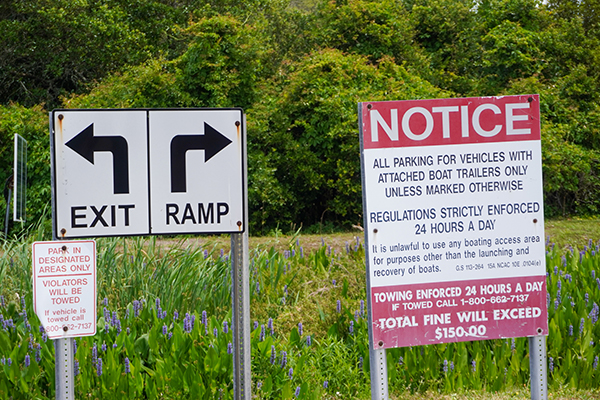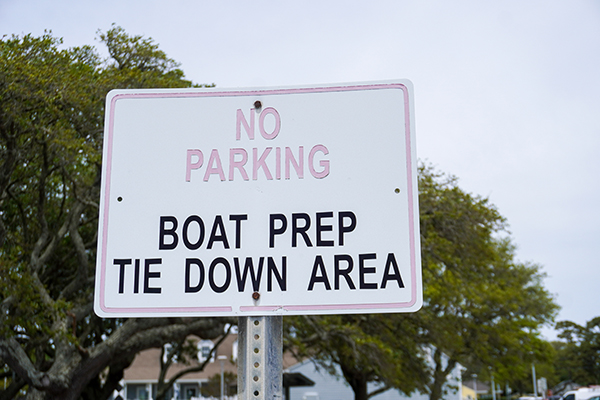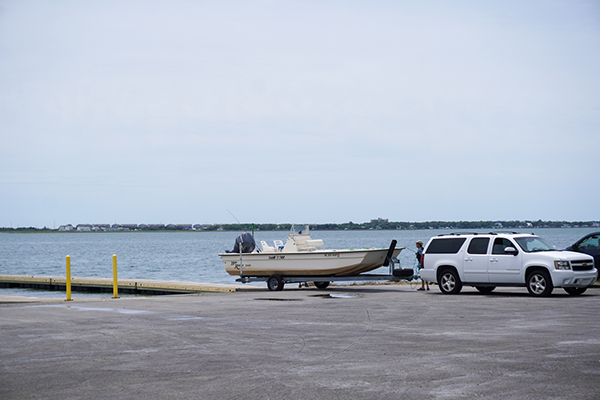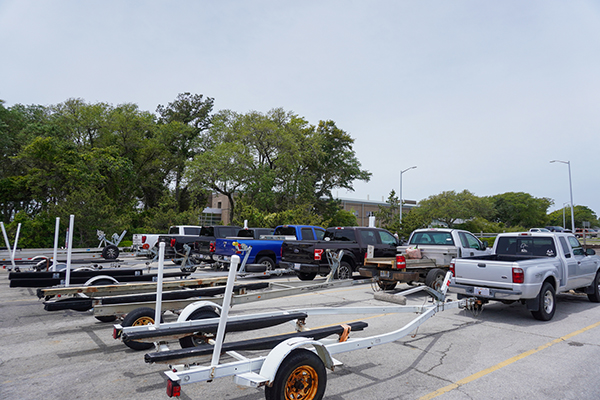You’ve got the boat loaded. The cooler is full of ice. Your rods are rigged and ready.
All that stands between you and a wonderful day on the water is navigating the boat ramp. When it goes right, this is no big deal. When it turns sideways, the boat ramp is an inclined crucible marked by stress and aggravation. What follows is an overview of boat ramp etiquette. It provides a framework for making the experience of launching and trailering your boat as smooth, efficient, and stress-free as possible. It is broken down into three phases—before leaving for the ramp, launching, and landing.

Before Leaving for the Ramp: The Prep Work
The foundations of boat ramp etiquette start before you leave your house. When you get to the ramp, you want to be sure that everything is working properly.
Be sure that your;
• Batteries are charged,
• Your gas tank is full and
• Your boat is ready for operation.
Everyone has seen the boater who waits until the trailer is in the water to discover that the boat won’t crank.
This is a terrible spot—and nobody wants to be that person. Not only will this ruin your day but if the ramp is busy, you’ll create a traffic jam.

You’ll also want to make sure that you’re familiar with the ramp layout before launching. The flow of trucks and trailers varies with the number of ramps available and the number of lanes per ramp. Having a plan for where you’ll launch your boat (before you pull into the marina) can save you confusion and avoid the potential for jamming traffic.
Not only can traffic patterns vary by marina, you’ll also want to make sure you’ll have a place to park. The same lot that is empty on a Tuesday afternoon might be jam-packed on Saturday morning. A word on preparation. Backing a boat on a trailer can be difficult. Be sure that before it’s time to launch your boat, that you are proficient in this art. There is no shame in needing to practice, but a crowded ramp full of other boats may not be the time and place. If you need to get used to how your trailer performs, consider practicing in an empty parking lot or in your driveway. There is less pressure this way. Your goal here is to minimize your time at the ramp and to expedite the process. This starts with the ability to put your boat and trailer where you want it and being confident that your boat will start.

Launching
The first piece of etiquette here lies in expediting your time at the ramp. You don’t need to be a NASCAR® pit crew, but you also don’t want to spend all day. When you are in the ramp, you want to be prepared. That means loading your cooler, taking off the straps, inserting your drain plug, and onboarding your gear in the staging area—before your trailer ever touches water. When you get to the ramp, just back in your trailer, unhook the winch, and offload your boat. You then want to move your vessel out of the ramp and tie up on some part of the dock that is out of the way of traffic that’s coming into or leaving the ramp. Move your truck and trailer, and park in designated area.
You’ll finish getting your boat and crew ready from the dock, clear out of the way. Be sure not to tie up too close to the action, but rather in a part of the dock that is accessible but also out of the way. As this might involve a bit of a walk from where you parked, you’ll want to load all of the heavy stuff—coolers, etc.—at the staging area before entering the ramp.
Landing
Here again, your goal is to minimize your time at the ramp. Pull back to the marina, select a spot of the dock that is safely out of the way of boats coming and going. Tie off your boat, offload your passengers and the person who will back the trailer down the ramp.
.jpg)
When the trailer is in position, pull your boat onto it. Secure the boat with the winch. Turn off the motors and raise them (if necessary). Once the boat is on the trailer and secured with the winch, pull out of the ramp and into the staging area.
It is here that you’ll complete the finishing touches of preparing your boat for overland transport. Secure the straps, offload your gear, ensure that nothing will fly out while driving. If you are boating in an area with invasive species, be sure to clean, drain, and dry your live wells and bilge. You’ll also want to remove any vegetation from your boat and trailer. Not only is this legally required in many places, it’s also one the best ways to prevent the spread of nuisance species.
Back to Blue Life
All that stands between you and a wonderful day on the water is navigating the boat ramp. When it goes right, this is no big deal. When it turns sideways, the boat ramp is an inclined crucible marked by stress and aggravation. What follows is an overview of boat ramp etiquette. It provides a framework for making the experience of launching and trailering your boat as smooth, efficient, and stress-free as possible. It is broken down into three phases—before leaving for the ramp, launching, and landing.

Before Leaving for the Ramp: The Prep Work
The foundations of boat ramp etiquette start before you leave your house. When you get to the ramp, you want to be sure that everything is working properly.
Be sure that your;
• Batteries are charged,
• Your gas tank is full and
• Your boat is ready for operation.
Everyone has seen the boater who waits until the trailer is in the water to discover that the boat won’t crank.
This is a terrible spot—and nobody wants to be that person. Not only will this ruin your day but if the ramp is busy, you’ll create a traffic jam.

You’ll also want to make sure that you’re familiar with the ramp layout before launching. The flow of trucks and trailers varies with the number of ramps available and the number of lanes per ramp. Having a plan for where you’ll launch your boat (before you pull into the marina) can save you confusion and avoid the potential for jamming traffic.
Not only can traffic patterns vary by marina, you’ll also want to make sure you’ll have a place to park. The same lot that is empty on a Tuesday afternoon might be jam-packed on Saturday morning. A word on preparation. Backing a boat on a trailer can be difficult. Be sure that before it’s time to launch your boat, that you are proficient in this art. There is no shame in needing to practice, but a crowded ramp full of other boats may not be the time and place. If you need to get used to how your trailer performs, consider practicing in an empty parking lot or in your driveway. There is less pressure this way. Your goal here is to minimize your time at the ramp and to expedite the process. This starts with the ability to put your boat and trailer where you want it and being confident that your boat will start.

Launching
The first piece of etiquette here lies in expediting your time at the ramp. You don’t need to be a NASCAR® pit crew, but you also don’t want to spend all day. When you are in the ramp, you want to be prepared. That means loading your cooler, taking off the straps, inserting your drain plug, and onboarding your gear in the staging area—before your trailer ever touches water. When you get to the ramp, just back in your trailer, unhook the winch, and offload your boat. You then want to move your vessel out of the ramp and tie up on some part of the dock that is out of the way of traffic that’s coming into or leaving the ramp. Move your truck and trailer, and park in designated area.
You’ll finish getting your boat and crew ready from the dock, clear out of the way. Be sure not to tie up too close to the action, but rather in a part of the dock that is accessible but also out of the way. As this might involve a bit of a walk from where you parked, you’ll want to load all of the heavy stuff—coolers, etc.—at the staging area before entering the ramp.
Landing
Here again, your goal is to minimize your time at the ramp. Pull back to the marina, select a spot of the dock that is safely out of the way of boats coming and going. Tie off your boat, offload your passengers and the person who will back the trailer down the ramp.
.jpg)
When the trailer is in position, pull your boat onto it. Secure the boat with the winch. Turn off the motors and raise them (if necessary). Once the boat is on the trailer and secured with the winch, pull out of the ramp and into the staging area.
It is here that you’ll complete the finishing touches of preparing your boat for overland transport. Secure the straps, offload your gear, ensure that nothing will fly out while driving. If you are boating in an area with invasive species, be sure to clean, drain, and dry your live wells and bilge. You’ll also want to remove any vegetation from your boat and trailer. Not only is this legally required in many places, it’s also one the best ways to prevent the spread of nuisance species.
Back to Blue Life
